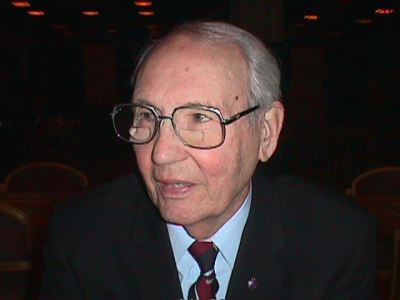
» Feedback
|
 |
Home | War History | WW2History-ViljoLehtinenEnglish.html
Icebreakers -
| |
Mannerheim Cross Knights outnumber radio operators
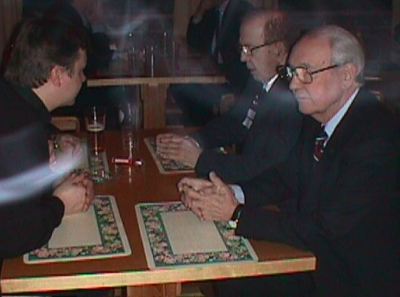 (Initial chat, a proper discussion starts gradually.)
(Initial chat, a proper discussion starts gradually.)
So Esko Tervo was a course mate of yours?
Yes, he was.
I'll tell him your warm regards.
I know he was supposed to be here, I saw a seat label with his name.
So you live in Oulunkylä, Helsinki. Mr. Aro lives close to you?
He lives some 300 meters away from me.
Wonder how he's living so near?
There just happens to be several of these fly boys there, just by
coincidence.
Who else do you know that live in Oulunkylä?
There's some Finnair guys, there's Pokela and... Leppä and... some guys from our squadron. But none of them are here today.
Funny how all just happen to live in so small area.
Yes, it's a pure coincidence. Ikonen and Pokela, they worked at Finnair. Well Pokela was in 34th squadron back then in wartime, means he was in Luukkanen's flight. Here's Esko Tervo... I have here an alphabetical list, an index of who received the radio operator/machine gunner insignia patch.
It was different from the pilot/navigator patch. Well the navigator doesn't really have a specific one...
Tässä (näyttää listaa Suomen Lentomerkin saajista) kaikki sähköttäjät mitä Suomessa on saanut sen, jok'ikinen.
This patch was established no sooner than July 10th, 1942. The first one to get it was Veikko Laukas, and then it was awarded until the end of the war. Here are all in numerical order, and the numbers run out on the next page, here: only 165 of them. That's all. Considering that, this is rarer than the Mannerheim cross. After all, they awarded 197 of those, but only 165 of this. I'd still trade, though.
You had to know signaling in morse code?
You betcha.
What kind of requirements you had?
Well, the requirement at the end of the course was 1st class, so almost
basic, but there was more training added to it.
That's 80 characters a minute?
Yes, about that. But when we took additional courses, our ratings rose
quite a lot. At wartime we had no chance to gain higher official levels,
like international class, but we could have attained those easily. We were
pretty good.
And then there were some flight hours and combat flights required, I don't
remember how many. In any case, here are all who got the patch.
It looks like this (shows his patch) but this is a miniature version.
Here's the big one.
That's a aiming reticle..?
Yes, it's a reticle. The pilot patch has a seagull here in the middle,
but this has the circle reticle of the machine gun.
| |
|
| |
Rangers were tough guys
I've myself been trained as ranger adio operator in Sodankylä, so I know these
signaling things.
Ranger radio operator? That's splendid!
If there'd be a war, I'd be dropped behind enemy lines to scout their
movements.
I know some guys who were doing that in wartime. They were in
Hämeenlinna at the same time as we were on the course. This goes beyond
the topic now... There was a fellow called Vorho, who led patrols behind
enemy lines, a Mannerheim Cross Knight. They had come back from a
particularly hard patrol. They'd been there 3-4 weeks with no supplies,
they had lost their rations, connections and radio, and just walked home
from God knows where in three weeks. Guess they were getting some R&R in
Hämeenlinna. I didn't know back then all that he did, other that he was a
Ranger, it's only later that I've read of what they accomplished there.
He got the Mannerheim Cross in unusual fashion. It was the Air Force
Commander-in-Chief who recommended him for scouting russkie air bases.
I've also met Esa Anttala (Finnish war book author, specially writing books about the Finnish rangers operations behind Soviet front lines) a couple of times, the one who's written novels
of long range patrols. They're amazing stories, and true. I don't respect
anyone more than these men, it takes strong physique and psyche. Genuine
iron men.
Yes, I've heard pilot veterans saying that it was easy to fly, when you
knew that you'd get home soon.
It was nothing really, compared to others who spent weeks out there.
| |
|
| |
Bringing back casualties
Now after my flying days, I've been taking part in the project of
bringing Finnish casualties of war back from Russia. It was the Ministry
of Education who began it, and now it's the Memorial Foundation of War
Casualties that's doing it. It must be some forty times that we've been
there. Of course I'm mainly interested in pilots, but of course we are
looking for all that we know of. I've brought three recognized pilots back
to Finland for burial, one Messerschmitt pilot, one Morane pilot and one
Curtiss pilot.
Can you remember their names?
Yes, I certainly do but... we don't talk of these things until, for
example, the family knows. It's better to reveal their names only once
their cases are properly closed.
The Messerschmitt pilot was Erkki Nukarinen, he was found near Heinjoki
and brought home. And you have to remember, they are not intact planes or
bodies any more, just scraps and remnants.
Was he seen to come down?
No, he went missing in action.
In any case, most of these finds are based on tips from Russians, people
who have been living and moving about in the area. They've been telling of
old Finnish things found there. We don't often get hints from planes
despite there being hundreds of them, because the Russians have their own
ways of handling these finds. There's many kinds of treasure seekers
there. Some are honest people who report us that they found a plane, come
to see if there's a pilot. Others aren't.
We have permission to evacuate casualties. Planes are a different matter,
they are usually in small bits. You can bring parts to Finland, but never
a whole plane. This Brewster of Pekuri (B-239 Brewster fighter found and recovered from Russia, see the BW-372 comes home from the war article from Danfort.net) was a unique case, it had landed
in water and sunk in one piece. Usually planes that fall get smashed to
bits. I'm certain that another whole plane will never be found, though
I'd be glad to be proven wrong.
Pekuri's plane is now in Ireland and we'll see where it goes next. It's
been worth a million dollars till now, wonder how much is needed to take
it to the Washington Aviation Museum. I don't think it'll go anywhere.
Finns cannot afford it and I don't think Americans will take it either,
because the first seeker who funded it all got badly cheated.
But let's go back to what we were talking about.
| |
|
| |
I got to the Bomber Squadron 42
...which was given this very rare flying badge. The course began in
Hämeenlinna, it started early in '43 and took about ten months. There
were some 30 guys starting the course, but five or six dropped out for
various reasons. In the end there were 28 of us were sent out to
squadrons. We were divided between the four squadrons of the 4th Flight
Regiment, it was a bomber regiment. I was assigned to the 42th Squadron
that was based in Värtsilä at the time, early '44. There I served until
the Russians gave up the effort and the Germans too fled from Finland, in
'45. In November I was civilian again.
| |
|
| |
Bombing on shoestring budget
So I came to the squadron and was assigned to the 2nd flight as a
radio operator/machine gunner. At first it was quiet, spring '44 was easy time. We
did some bombings, but they felt like practise missions.
What were your target areas?
They were in East Carelia, Sekehe and then there was some base for ice
sleds... Then in April and May '44 we did a couple to the Aunus Isthmus,
the Merkino and an other airbase. But we saw very little bombing activity.
Like the Air Force today, we were saving our equipment, planes, fuel,
everything. There were very few training flights, too. I criticized it
back then. Fighter squadrons in the frontline couldn't be held back,
because they had to react to enemy activity, but bombing squads had to
save everything. Perhaps they were unwilling to take risks anymore, after
suffering serious losses from own mistakes before.
| |
|
| |
Bombing and recon flights in Carelian skies
Did you ever fly with Pentti Aro?
Yes, many times. We had all kinds of adventures, maybe partly because
of our own mistakes or maybe not... Pena and I, we've been through a lot.
In the war and after, too.
What kind of mishaps did you face?
What has Pena told you?
He told some stories...
The one of getting lost?
No, not that one. He told a story of some six or eight Blenheims, who
were going to bomb but missed their opportunity. Then two enemy fighters
arrived and they had to make a low-level escape. Running away at 600 kph
at treetops, finally losing them...
I don't know of that. Did he tell others stories?
Then the bombing of Germans...
The one, when the navigator said, 'we're not going to bomb friends,
are we?'
Yes, that one. They dropped the bombs when the plane on the wing took a
direct hit, then flew back between two hills...
We never encountered German fighters, thank God. We'd be goners for
sure. If a 109 goes after a Blenheim, there's no debate what will happen.
Only if you go so low that your belly scrapes the ground and swerve like
hell every time it makes a run. Still it's hopeless to keep a 109 at
bay with one Browning MG, if the enemy pilot isn't a complete dunce.
Yes, we flew a lot with Pena. He was a great friend and a popular pilot.
He's a great guy. Good natured and talented.
We didn't do many bombing flights in spring '44 because of all those
savings. Only that ice sled base - the Russians had helluva big sleds with
airplane engine and propellor, and used them to make attacks over Lake
Ääninen - and some partisan base of theirs, can't remember where they
were. But we photographed at Syväri. Our squadron's recon area was the
Aunus Isthmus, between the River Syväri and Lakes Ääninen and Ladoga. We
had several planes filming there.
How the photographing was it done?
It was simple. We took off from our base at Värtsilä and flew to
Nurmoila, that's near Syväri. We got fighter escort there, they had
Curtiss Hawk 75s the Fighter Squadron 32t there. With escort, we went over Syväri
and photograped between the power plant at Syväri, Lotinanpelto and Lake
Ladoga. We did several trips to the area. It was done by flying in line,
in certain order to cover the entire area. It went quite well, but it was
rather monotonous work. Flying in 6,000 meters straight, then turning and
straight again, in line.
Who took the photos?
The camera is in the back... You know where the crew are seated in the
Blenheim? The pilot is in front on the left, like in all planes. Here's
the navigator. The radio operator/gunner's cupola is here, in the middle hull. And
the camera is a bit forward of the cupola, it's fixed there by the ground
crew.
Who shoots with the camera?
The navigator in the front. He's the one who checks the plane's
direction. When approaching target, he guides the pilot, now left, now
right, now straight. Then we fly in line. The plane shouldn't stray from
the path but go like on rails. The navigator operates the camera. If he
gets really curious, he may tell the radio operator to check the camera's
function and the photo number. The camera does automatic movement,
covering the entire area when the plane makes passes over the target
area. The film is a big plate, 30x30 cm in size, and the frames overlap a
bit.
It's really innocent work, nobody should be punished of doing it, but the
enemy AA doesn't like it at all. Wherever there's a battery, they shoot.
6,000 meters is pretty safe altitude, 20mm or 40mm guns don't reach
that high. A heavy gun can hit when straight over it. They shoot what they
can, but fighters are really the biggest threat.
| |
|
| |
Dangerous play with enemy fighters
The Alehovchina and Merkino airbases were near there, and they were
alerted when a recon plane was spotted. Fighters came after us, and the
only thing we could do was to run for it. A bomber has no choice but run.
When the Americans did daytime bombing to Germany, they flew in huge
formations with hundreds of planes. They relied on closed formation and
massive defense fire rather than dodging the enemy. But when there were
enough Germans attacking, some got hurt.
But we had only one plane, and even if we had had the entire squadron,
there wouldn't have been chance to defend ourselves. Escape was the only
chance. If there were clouds near, we used them. Otherwise we'd go to
power dive, no matter what altitude we were in.
But we had only one plane, and even if we had had the entire squadron,
there wouldn't have been chance to defend ourselves. Escape was the only
chance. If there were clouds near – which luckily happened once also - we could hide inside the cloud and that's it then. Otherwise we'd go to
power dive, no matter what altitude we were in. Our photographing altitude was 6000 meters.
But once they surprised us, even if we had six Curtisses around.
They came from the cirrus clouds overhead and suddenly were behind our
rudder. The gunner could only call out of the LaGG in the rear, dive to the deck! Then you
push the nose down and dive. The Blenheim was good in dive, it doesn't
break. The plane could take all that the crew could. The speed could rise
to 640 kph in a dive, but not over. Then you pull out near the ground and
fly away as low as you can, and no fighter can follow. Like now, only one
La-5 followed us all the way down, kept firing at us and I shot back with the
puny Browning, and the game ended 0-0, like any good game. Nothing happened to us and in the end, we returned in one piece to Nurmoila.
How far was it worth trying to shoot with the Browning?
300 meters was too long, it had to be closer.
You had tracer bullets?
Yes, you could choose to load with more or less tracers. They are
better, because you don't fear what you don't see, but when you see
the tracers going close by, it's shocking. You dodge, even if you're not hit.
They fly in kind of a funny way...
Yes, well the bullet flies straight, but because the plane moves, it
looks like the the bullets weave. Like you can see in films. It's not the
gun that moves, it's the camera.
Anyways, we were running home, and the Russian found it hopeless to come
after us. A fighter, La-5, can't dive after Blenheim, it's speed rises way
too high and russkie planes weren't very good divers anyways. Not even
La-5, which was an excellent plane. It had to pull aside to slow down and
try again, otherwise its speed takes it right past.
So it gave up the chase and turned away, I forgot to check the altimeter
at which point it was. One of our Curtiss escorts went after it, as it
flew home towards the Merkino base. There was some 500 meters between
them. They flew from the Aunus Isthmus along Syväri, crossed it at
Lotinanpelto and towards Merkino. Then it dawned to the Curtiss pilot that
the La wasn't leaving him behind even if it could fly 200 kph faster. He
couldn't get any closer even if he pressed the throttle with both hands. No, can't get any closer he thought and thought that it was luring him as far to their side as he would follow, if he would be stupid enough.
Hell no, he decided and turned back, climbing higher, and crossed Syväri
again near Aunus town. And he kept looking back to see if 'Vasili' was
following, but didn't see. So he calmed down and was thinking ”ok I'm home soon”, when suddenly there was a hell of a crash in the plane, bullets flew from all sides and the right earphone was shot off the canopy. There was a moment of silence, then another crash, and the plane felt all limp.
The pilot kept the stick to the side so the plane was barely held aloft.
After a moment the La-5 came to his side. I asked him how close it was,
and he said it was scant ten meters, maybe he exaggerated some. The La
pilot, a dark guy, just waved like this and turned away. It ran out of
ammo! That's the only explanation I have, why else would it have left. The
pilot, Erkki Arikka, tried to slow down the plane for landing but the plane almost got out of control. He managed to regain the control though, then turned it upside down and left the plane.
That was our loss, the rest of us got to the base.
The funniest thing is that I've read the Russian debriefing from their
archives. There was the La pilot's name and his story of the incident.
He's telling of shooting down a Curtiss, and that's true. But he's also
telling that he hit another Curtiss and a Blenheim, too. He didn't, our
plane was intact.
| |
|
| |
Photographing the entire front at Syväri, repelling the Soviet offensive
Where was I now... So we had only few bombing flights, but plenty of
photography. We filmed the entire Syväri frontline then. I don't know why,
but it was done every fall and spring before weather got muddy. This was
March 25th, St Mary's day. The frames went to some HQ, where they were
examined. I don't know what they found of them, something I guess.
The real action began in June 9th, when the Soviet summer offenseive began in
Valkeasaari. The first day was still successful, but the Russians broke
through at Valkeasaari on the 10th, and that's when the war really began for us.
I mention the other squadrons now as well. The Dornier squadron attacked the Russian front at Kivennapa-Jäppilä on 11th. Three of the six Dorniers were lost. One of them was shot down by
our own AA, but that's nothing to advertise about.
The 12th was the first day for our squadron. We bombed the Kivennapa
region, and sustained some losses. Not many, our squadron was very lucky.
There were close calls, damages and forced landings but nothing very bad,
no planes were lost. We came out in quite good shape.
The Bomber Squadron 46, the Dorniers, lost half of their number on their first
mission, and the 48th fared worse than us too. 42th did fine. It's not
because we were better, it was pure luck. In air combat, when you have AA
and fighters against you, skills don't help much. It's all luck and
blessings.
| |
|
| |
The regiment operated like one fist
 We did lots of missions that summer. Always when the weather was
favorable, we went to wherever the hot spots were. To Tali-Ihantala, as
many flights as we could. Then the front moved to the Viipuri bay, then to
Teikari Island. At the Teikari battle, we bombed the gun emplacements at
Uuras. Finally the pressure point moved to the Äyräpää-Vuosalmi front, and
it became the main target. We flew over Vuosalmi many times a day. The
entire regiment worked like one fist at that time.
We did lots of missions that summer. Always when the weather was
favorable, we went to wherever the hot spots were. To Tali-Ihantala, as
many flights as we could. Then the front moved to the Viipuri bay, then to
Teikari Island. At the Teikari battle, we bombed the gun emplacements at
Uuras. Finally the pressure point moved to the Äyräpää-Vuosalmi front, and
it became the main target. We flew over Vuosalmi many times a day. The
entire regiment worked like one fist at that time.
Every one of our squadron was on every flight. They were timed at 1-2
minute intervals, so the entire bomb load of the squadron rained to the same
target. In the end, things calmed slowly down at Vuosalmi and the battles
moved up to Ilomantsi. Our work lightened, so that there could be long
times between flights. The last flights were photography again. I think I
was on our regiment's last war flight, it was a photography flight at
Tolvajärvi-Ägläjärvi.
Then it was over. We packed up our stuff and wondered what's going to
happen now, when the opponent got tired. It didn't take long before the
war in Lapland began.
| |
|
| |
German AA was the worst threat during Lappland war
We were moved to the airbase at Paltaniemi, near Kajaani (to operate against the Germans, during Lappland War 1944-1945).
You didn't see any German fighters?
Fighters? No, we were never attacked by them. Maybe we saw some, but we
didn't stay to take a good look, we came home low. But AA was so much
worse. You know the weather in Lapland in October, the clouds hung at 400
meters and we had to fly low. And the Germans had really heavy AA.
Aro mentioned this multibarrel gun...
The Vierling. The German had this excellent weapon, four 20mm guns on
the same base. It's an awesome weapon for low-level defense.
They all fire together?
Yes, yes, with the same trigger. The Russians had the one with four
Maxim MG's, but that's a toy. But this German Vierling, with four 20 millimeter automatic guns, it's outright scary.
Wonder how fast it fired.
I think it was the same gun the 109 had. Each barrel shoots 700 rounds
a minute. It's dreadful. If a plane comes to range, it's gone. Then they
had the 37 mm gun, and the heavies. Also what was new to us, when we were
flying above clouds, there suddenly were puffs of heavy AA around us. How
in hell can they shoot here? Then we realized, they had radar! The heavy
AA aimed with radar and clouds didn't matter at all. We hadn't even known
what a radar was, until then. But it was not as dangerous as flying low. To think about it, flying at 400 meters against such AA.
So had the Russians, even worse, but we never flew low against them.
Russian targets were areas and they were bombed from high altitude,
2,000-3,000 meters. In Vuosalmi, where their AA was dreadfully heavy -
they said they had 20 heavy batteries in addition to light ones - we flew in
4,500-5,000 meters. The light guns wouldn't reach that high, only the
heavies. Sometimes when they shot in our front, it felt like no one could
go through that. But there was no choice, and it was possible. But this German low level AA, it was horrible, they shot down many Brewsters and Blenheims...
I remember one flight, it was at Kittilä or Ranua. We had to bomb marching
columns on a road. It was frightening. The clouds were at 300-400 meters,
so we had to go low. When we approached the road, there was such a lot of
sparks coming at us that we had to dodge to the side. There were snaps
ringing all around the plane and I tried to look where we were hit...
Back in the base we started looking more thoroughly where the daylight is shining through and we found 9mm submachine gun bullets in the flare ammo box. You see, when you go over a marching
column, every man had lifted their guns and shot. SMG's, rifles, machine
guns, all. You never think of infantry as a threat, but they can be a real
danger. When an AA gun fires, it all goes to the same place. But when
there's lots of men shooting at you, one is bound to hit something.
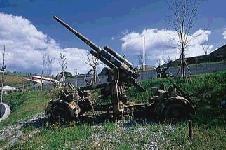
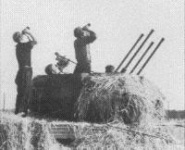
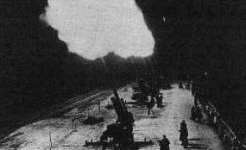
| |
|
| |
Goddamnit, did that bait work... My way to the Airforce was open...
That was the war against the Germans. The northernmost place where we flew
was Karesuvanto. The bomber fleet suffered heavy losses. We were then
forbidden to have bombers in the peace agreement, and we wondered if
they'll be got rid of by having them all shot down.
But all in all, if you're asking what impression I got of the Air Force...
I volunteered in late July '41. I had applied to every damn place when I
was 16, but of course I wasn't accepted yet. I was in the air surveillance
troops in Carelia, walking all the way round and round Karelia and Karelian isthmus. When I turned 18 years old I was released from the service, me, a old war veteran. But all
who were 17 years old were sent home. And I use to say, that perhaps Mannerheim thought he'd manage without me. But it was only four months when I was called for again. I was
put to infantry, first to Hamina training base. But I didn't think it was my kind of
stuff, I'm not so good at walking. I applied everywhere I could, to every possible place I could send my papers, and was accepted to Anti-Aircraft.
I spent a year in Viipuri air defence. Then by coincidence, by some most wonderful, unexplained way I came upon some papers that I wasn't even supposed to see, but I was doing night
shift and there was nothing better to do than read them. They were about flight radio operator course in the Signals School. I sent the application immediately and included that certificate from the Flight Surgeon's Office (tai Aeromedical). And Goddamnit, did that bait work! That was the best thing I did in my life.
| |
|
| |
Back to civilian life
Dear God, if I had remained a ground-pounder all those three years. But
the Air Force, it was heaven to a guy who's read aviation books instead
of schoolbooks since ten-year-old, books by Tapani Harmaja and every book I just could find. And as I said, I was never forced to any place (in the Armed Forces), I was accepted. And that's the truth. And I dare to claim, that every guy who was in the Air Force can agree with me.
So in mid-November I got a notice that fatherland will try to cope without
me, and sent me home. The was was over, but in the following decades I've
been back in Carelia many times. I've been there at least 40 times looking for our fallen soldies and of course I'm especially interested in pilots. If a plane is found there, it's really exciting to
check first its type. The texts in the plane already tell a lot to us. If there's Russian text, it doesn't interest us much, though it can still be one of the Chaikas that we got as spoils of
war. But if there's German, it can be one of ours or German's. Perhaps it could be a 109, because
we had no Focke-Wulfs. If there's French, it's certainly a Morane, we got them from France you know. Moments like this are savored, there aren't many of them.
| |
|
| |
More on recovering casualties
Have you seen many such planes, where there is still a pilot... ?
Yes, several. Ours and Russians. Messerschmitts, a Curtiss, then the
Russian La's and Yak's. Even remains of a Blenheim. We've gone over lists,
where planes got shot down or disappeared, and located many. They're in
lakes, and... here and there. Hard to find. It takes money, diving
equipment, boats and all that. We have volunteers, no one of us asks for
pay but we're happy just to get there. But we need funding, because it's
expensive. A couple of hundred of Euros is nothing, can't even rent a car
with it.
And don't you need permissions and such?
Yes, but paperwork isn't difficult. We get visas, and no one really
opposes our work, it's all ok. It's all about money, how much you can
invest. Car rentals, lodging, and all. I've paid many trips from my own
wallet.
Before it was the Ministry of Education that arranged searches for
casualties. Now we have the Memorial Foundation of War Casualties. There
are also war veteran organizations and families and all kinds of societies
that help us, but the work is limited. But I'm still going to visit there
this Summer.
| |
|
Last modified: 2002-09-23 22:13
|
|

